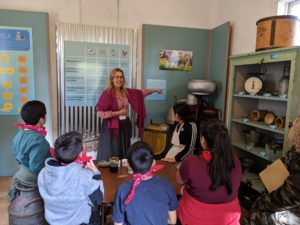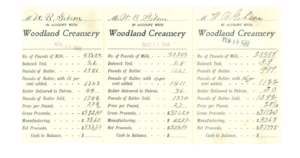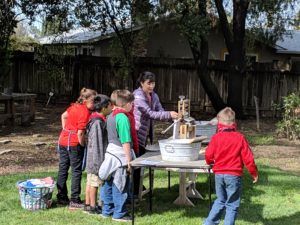Hey Yolo! Jenna Harris here, YoloArts’ Education Manager. I’ve been asked to take over the newsroom today and share how we use our Dairy Exhibit at the Gibson House to give students and visitors a glimpse of life in the late 19th and early 20th centuries.

Why is the dairy exhibition important to YoloArts’ historic education programming?
The rise of the dairy industry in Yolo County greatly contributed to the development of our city’s infrastructures and the county’s agricultural prosperity.
The first dairy farmer in Yolo County was Jerome C. Davis, in West Sacramento previously known as Washington or Broderick, which operated from 1849 to 1870 with 250 dairy cows.
On November 1,1865, Herbert Coil invested his Holstein cows and $6,000 in the creation of the Woodland Creamery, which processed an average of 20,000 pounds of milk and 800 to 1,000 pounds of butter, per day. The Woodland Creamery grew to be one of the best equipped institutions.
By the late 1800s many farmers, including William Byas Gibson, turned their attention to the production of dairy products such as milk, butter and cheese, which commanded higher and steadily growing prices, unlike the fluctuating grain prices. Farmers felt the necessity for a local market for their dairy products and found a fruitful business in the manufacturing and distribution of milk, butter and cheese, which could be manufactured and sold year-round.
The rise of the dairy industry affected the crops farmers planted. After the wheat market crashed in late 1890s, farmers began to seed their fields with alfalfa in the spring to make sure their cows had enough feed for their cows when winter came.


What do you hope students learn on a virtual or in-person visit to the Gibson House?
Our goal is for students to walk away with an appreciation for life in the 21st Century, a general understanding of Farm to Fork dairy practices at the turn of the 20th century, respect for the labor of our forefathers and foremothers to care for the livestock, churn butter, and store food during the late 19th and early 20th centuries, and most importantly a sense of pride in their communities history.

How do you get students excited about local dairy industry history?
We start by learning about Dairy Animals – Cows, Goats, Sheep, and Chickens – as well as what a day in the life of a young farmer might look like. On display in the Dairy, we have art work from the last 2-3 years of Art & Ag project on display. We use these art pieces to discuss animal care, traits, and habitats. We then use all this knowledge about the animals to learn how to turn milk into cream, butter, and cheese. Students even have a chance to “churn” their own butter in a hands-on activity.
Can students and their families make butter at Home?
Yes, and here is how.
You will need to gather the following supplies:
- Heavy Cream
- Glass Jar & Lid
- Sieve/Cheesecloth
- Cold Water
- Spoon
Once you have your supplies gathered follow these steps for home made butter.
- Fill a glass jar with about an inch of room temperature heavy cream
- Fasten the Lid Securely
- Shake! Shake! Shake! How long depends on the size of your jar. Our 2 oz jars take about 10 minutes of steady shaking. During this time, the butter will go through three stages and you can watch/listen for each. First, it starts out as a liquid so you will hear sloshing sounds. Second, you will notice the sloshing lessen as the butterfat collects into a solid, you might hear it rattling back and forth like a soft marble. Finally, the solution will separate into butter and the buttermilk. At this stage you should be able to hear both sloshing and rattling.
- Once the butter has formed, more the mixture through a sieve or cheesecloth into a bowl. The liquid is buttermilk. Store-bought buttermilk is ‘cultured’ like yogurt. Pioneer farmers saved and used the buttermilk for baking or drinking. Our fresh butter will sour if we don’t get all the buttermilk out. Once rinsed, we can salt and store it for future use.
- Rinse the lumps of butter in cold water.
- *Optional* Salt your butter.
- Press the butter with spoons to make it smooth.
- Transfer the butter to a serving or storage container and Enjoy!
Field Trips at the Gibson House and Property, are high-quality, standards-based educational experiences led by our dedicated docents. The house has been preserved to reflect the history of Yolo County and its diverse community. Students will get a glimpse of life in the late 19th and early 20th centuries.
The 3rd Grade Historic Experiences includes a tour of the Gibson House and Agriculture Collections as well as hands-on Butter-Making, Laundry, and Victorian Era Games activities.
K-12 Gibson House and Property Tours experience the Gibson House, Blacksmith Shop & Agriculture Collection, and The Barn Gallery.
Learn more HERE.
Jenna Harris, YoloArts Education Manager, received a B.A. in Art History from Sonoma State University and proceeded on to graduate with a M.A. in Curatorial Practice from California College of the Arts. Throughout her studies, Harris was (and still is) passionate about various Visitor Engagement Strategies and how they are utilized by different institutions. In the past, Harris has worked for several non-profit arts organizations, Sandra Lee Gallery in San Francisco, taught and managed multiple children’s gymnastics, camp, and art programs, and curated exhibitions throughout the greater SF Bay Area. Harris manages the I SEE YOU project, Artists in Residence program, and Gibson House Field Trips and Public Programs.